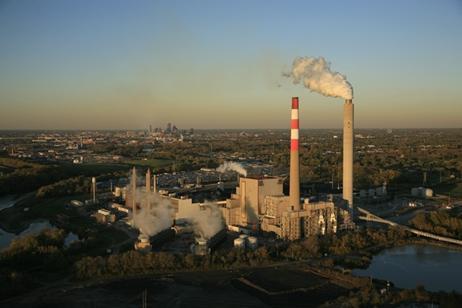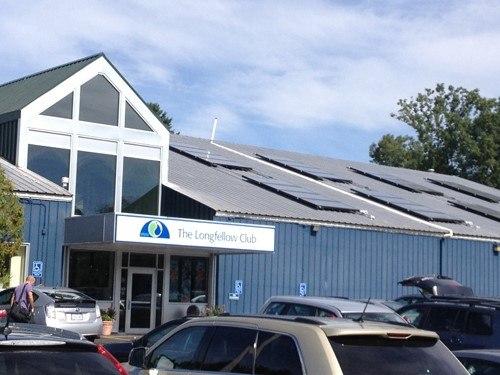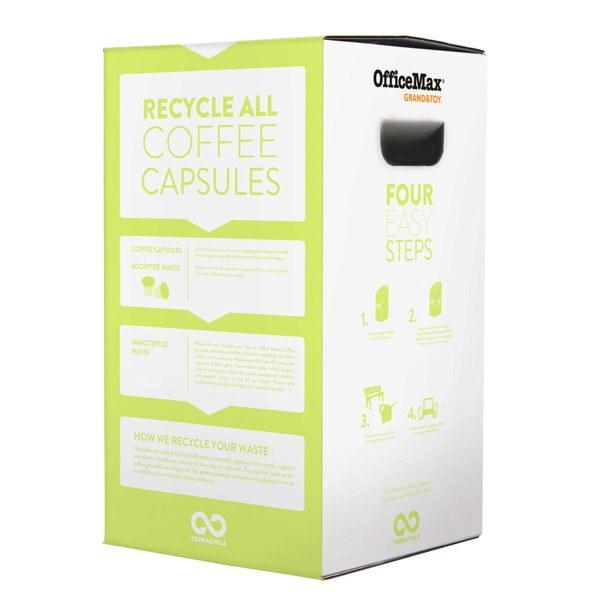Big 'Beyond Coal' Victory for Indianapolis Grassroots Coalition


Persistence and grassroots political activism finally won out in Indianapolis recently: On August 15, Indianapolis Power & Light (IPL) announced it will stop burning coal at its 1,094-megawatt Harding Street power plant – the only coal-fired power plant remaining within the limits of a major Midwestern city – and switch to natural gas-fired electricity generation by 2016.
The announcement marked a big victory for “small 'd' democracy,” one Indianapolis City-County Council member remarked. It was also a win for Power Indy Forward, the broad-based coalition of environmental and public interest groups that came together to persuade IPL and government officials to phase out the use of coal in electricity generation. The coalition is also lobbying for environmental and social remediation efforts, energy efficiency programs and goals, and much more in the way of clean energy generation capacity.
“More than 55 organizations comprising the Power Indy Forward Coalition have been working hard for this day, and we thank IPL for making the decision to stop burning coal at the Harding Street plant. The community fought for clean air and a plan to protect the health of our families by phasing out coal in Marion County,” Jodi Perras, senior campaign representative for Sierra Club Indiana Beyond Coal, wrote in an August 15 op-ed in the Indianapolis Star.
Moving 'beyond coal' in Indianapolis
IPL's August 15 announcement came suddenly and as a something of a surprise to Power Indy Forward, which was expecting the council to adopt another resolution sponsored by Councilman Zach Adamson. The resolution called on IPL to, among other things: include a thorough cost-benefit analysis of ceasing coal use; clean up coal ash ponds; and make a transition to clean energy resources in its new 20-year integrated resource plan, which the utility is due to submit this November. It also called on IPL to take steps to assure the livelihoods of affected coal plant workers.
“We knew we had the votes to pass the resolution, so IPL coming out with its announcement the Friday before, after we knew we had won the hearts and minds of the city-county council, it was a huge victory for us,” Jodi Perras told Triple Pundit.
IPL's Harding Street power plant is by far the biggest polluter in the Indianapolis metro area: Toxic emissions of mercury, carbon and sulfur dioxides, and nitrogen oxides from the plant have been taking a heavy toll on residents' health and safety, as well as on air, land and water quality, since its first generating unit came online in 1958.
The plant, Perras told 3p, has been degrading the environment and badly affecting the health of Indianapolis residents for a long time, “But the community hadn't put it all together. When they did, it made a big difference and enabled us to bring about change.”
The cost to the average utility customer of IPL's decision to stop burning coal at the Harding Street power plant: $1 a month. “That's less than the cost of continuing to burn coal for 20 more years at the Harding Street coal-fired power plant on the Southside,” Perras wrote in her IndyStar op-ed.
IPL officials highlighted that switching from coal to natural gas at the plant would reduce its dependence on coal from 79 percent in 2007 to 44 percent by 2017, IndyStar reported. The company said the decision was made in order to comply with Environmental Protection Agency (EPA) regulations and would result in an increase in customer utility bills of about $12 per year.
Galvanizing grassroots support
Rebuffed by IPL and government officials since 2012, residents -- along with students, faculty and staff from Indianapolis universities -- joined with civic and religious leaders, Hoosier Interfaith Power & Light and the local chapter of the Sierra Club's “Beyond Coal” campaign, in April. Together, the stakeholders combined resources and intensified their lobbying efforts by forming Power Indy Forward, Perras recounted.
Less than six months later, while awaiting a decision on Adamson's resolution, the coalition learned it had accomplished one of its main goals -- far earlier than expected.
“IPL's announcement that it will stop burning coal at the Harding plant and switch to natural gas by 2016 came four years earlier than we asked, and at a cost of only $1 per month for the average ratepayer,” Perras noted.
“They said citizen pressure had nothing to do with it, that is was an economic decision brought on by regulatory requirements.” More specifically, IPL was referring to a new regulatory requirement that the utility obtain new wastewater permits, limit wastewater discharges and invest in a wastewater treatment facility. “They concluded it would cost less to switch to natural gas,” she said.
Perras begs to differ. “The grassroots movement made a big impact. We delivered over 1,000 letters to the council that included the names of residents in their districts.” Then there were the thousands of phone calls made to Indianapolis council members, as well as numerous one-on-one visits. It seems grassroots U.S. democracy isn't dead after all.
*Image credits: Power Indy Forward; 2) Arena
Verizon Ups Its Green Energy Commitment by Another $40 Million


The race is on: Yesterday Verizon Communications announced that it was committing another $40 million to its green energy program, paving the way for the company to expand its solar power market in five key states.
The investment will provide funding for an additional 10.2 megawatts at eight sites in California, Massachusetts, Maryland, New Jersey and New York, effectively raising the amount of green energy it will deploy to more than 25 MW once the new installations are completed.
Verizon announced its entry into the solar market last year with the investment of $100 million to install solar panels at 19 locations across the country. The initial investment was expected to generate more than 70 million killowatt hours at sites in seven states, providing power to offices, as well as data and call centers. The company says it has since enhanced its green energy investment at some of those locations by introducing cooling measures designed to reduce its carbon bill even further. Its total investment will also eventually allow Verizon to offset its carbon footprint by 22,000 metric tons of CO2 (the equivalent of removing 5,000 vehicles from the road per year).
This latest expansion ups Verizon’s capabilities and puts it in the running to become the nation’s No. 1 solar-producing communications company. James Gowen, Verizon’s chief sustainability officer, said the company’s move dovetails with its goal of cutting its carbon bill in half by 2020.
“Our investment in on-site green energy is improving the quality of life in the communities we serve by reducing CO2 levels and reducing strain on commercial power grids, while increasing our energy efficiency,” Gowen said.
The expansion also means that Verizon will soon join the ranks of the top 20 companies with the largest number of solar installations in the country.
Verizon contracted with SunPower to install the solar arrays, which include a rooftop installation on a parking structure and several ground-level photovoltaic systems.
Image credit: pgegreenenergy
Sustainability Drives Healthy Results at Longfellow Sports Clubs


The Longfellow Clubs (LFC) is a cluster of five multi-purpose health and recreation facilities located in Sudbury, Wayland and Natick, Massachusetts. LFC is the fourth-largest health and recreation club in New England with 125 full-time and 300 part-time employees. This mid-sized, highly successful company has actively implemented sustainability-based business practices across all of its facilities, significantly enhancing its financial performance and developing a reputation as the greenest health club in America.
Laury Hammel, co-founder and CEO, says he has been committed to environmental issues since his childhood. “I participated in the first Earth Day in 1970. I think my childhood really crystallized and catalyzed my sustainability efforts.”
Hammel founded LFC in 1972 as a tennis instruction business. Rapid growth drove him and business partner Myke Farricker to find larger facilities. They purchased an existing facility in 1980. Since that initial acquisition, they have been acquiring, upgrading and enhancing athletic facilities across the greater Boston area to better meet community and customer demands for health and fitness programs. Facilities improvements include water conservation, energy efficiency and earth-friendly facilities that encapsulate a holistic approach to health for people and planet.
One of LFC’s missions as a locally-owned and independent business is a commitment to the health and wellbeing of the communities in which it operations. Other LFC missions are to provide extraordinary fitness, recreational and educational programs for people of all ages, backgrounds and abilities.
The result of implementing environmentally-friendly business practices is that LFC has prospered for over 33 years, successfully established a positive reputation with the communities in which it operates, a strong competitive position and fiscal resiliency in its market.
LFC’s sustainability journey started at the core of the business. Health and recreation facilities are capital intensive due to the physical infrastructure requirements. They can also be highly toxic environments with harsh chemicals for cleaning and sanitizing the facilities and equipment as well as for the pool. Additionally, recreation facilities demand high energy and water usage. Hammel and Farricker took a hard look at these operational imperatives and determined there was a better, healthier way to run a health club. The starting point for sustainability, however, was basic recycling.
Health and recreation facilities generate a significant amount of recyclable waste. Hammel started LFC’s sustainability initiatives by addressing recyclable paper, cardboard and containers across all of its facilities. This initial step now diverts approximately 4,098 pounds of waste from the company’s landfill-destined waste stream each month. The recycling initiative engages everyone who visits the facilities including staff, members and visiting patrons.
In 1989 LFC created a checklist to use as a reference for sustainability measures to pursue. The company embarked on a series of capital expenditures aimed at decreasing its environmental footprint beginning in the early 2000s. It continues on this path today, continually seeking new ways to improve its facilities and delight its patrons while concurrently reducing its environmental impacts.
In 2004, solar hot water heaters were installed. Ongoing growth of the business drove continuous expansion of the solar hot water systems; and in 2009 the firm was recognized as having one of the largest solar hot water systems in New England. At just one of the LFC facilities, the use of solar hot water heaters saves the company approximately $10,000 annually in energy costs.
In mid-2007, waterless urinals were installed. These urinals eliminated 80 percent of all flushes in the men’s locker rooms. Each urinal reduces water usage by 45,000 gallons annually.
A few months later, a co-generation unit was installed. This unit heats the pool and shower water using the waste heat generated from the natural gas electric system. The co-generation system has reduced LFC’s water heating costs by about 7.4 percent annually. In early 2009, LFC replaced all of the 3.5 to 4 gallons-per-minute shower heads with low-flow, 2 gallons-per-minute alternatives. This modification saves the company hundreds of thousands of gallons of water each year.
LFC installed an industry-leading saltwater purification system for the clubs’ pools earlier that year. The rock salt system, Board of Health approved, allowed LFC to eliminate 99 percent of the chlorine it used for cleaning the pools’ water.
When chlorine combines with water and things such as hairspray, makeup, sweat and sunscreen, it creates volatile chemicals. These chemicals are in the water and get into the air through vigorous churning of the water. Called disinfectant byproducts in the industry, these chemicals make up the smell one notices in a pool environment. These byproducts have also been linked to many health issues. By eliminating chlorine in its pools, LFC is providing a safer, healthier environment for everyone.
LFC’s sustainability initiatives are not limited to waste reduction, improved water usage efficiency and toxic chemical elimination. Look out for Part 2 in which we will describe the company's energy saving programs and how it has stimulated sustainability-based thinking in the communities in which it operates.
Image courtesy of the Longfellow Clubs
Top Energy-Efficient Apps and Devices for Everyday Use


By Jessica Oaks
Saving energy is on most people’s minds these days, whether it’s at home, at the office or with the multitude of devices and appliances they use.
Luckily, that smartphone or tablet can help you develop some great conservation habits by giving you access to useful apps that make living a greener lifestyle easier. Considering a device or appliance that is energy efficient isn't a bad idea either.
To save you some time searching through online reviews, check out these top energy-saving devices, appliances and apps you can use every day.
Smartphone with Ultra Power Saving Mode
A smartphone or tablet’s battery life is constantly a point of contention for many consumers. They want their devices to last for a longer period of time, but they aren’t cutting back on their time spent using them. A good solution that just recently hit the market is the Samsung Galaxy S5 with Ultra Power Saving Mode. This device has a 2800 mAh battery and squeezes an exorbitant amount of energy out of it.
When placed in Ultra Power Saving Mode, the Galaxy S5 turns off color and switches to black-and-white mode. It also turns off most connectivity options. Because of this feature, it is possible to extend the smartphone’s battery life by an additional day. Overall, the Galaxy S5 should last through 10 hours of Web browsing and 12 hours of video. Users can also remove the battery and replace with a charged one if necessary.
Energy-efficient appliances
Saving energy around the house is easy to do if you have one of the trendy, energy-efficient appliances to use. Appliances that meet the standard for energy savings are part of the Energy Star government initiative to save money, as well as environmental impact. Popular appliances that are part of this program include:
- Samsung French Door Refrigerator: Besides delivering fresh water from the refrigerator and making up to 10 pounds of ice a day with its dual ice-maker, this product has high-efficiency LED lighting and a twin cooling system to keep fruits and vegetables fresher longer.
- Kenmore’s Elite Front-Loading Washing Machine: Designed for shortened washing, this washer saves up to 30 percent on time (also cutting back on energy use), while still doing a quality job.
- KitchenAid Architect Series Dishwasher: This dishwasher has eco-friendly options including ProWash, ProDry and air-dry. These features allow consumers to use less energy, and the appliance is estimated to use only about $33 worth of electricity per year.
- Nest Sense: This personalized thermostat connects with your smartphone or other device to help you save money on energy bills. Besides creating a personalized schedule, users can connect to the thermostat with the Nest App to keep track of their energy use when not at home.
Energy-saving apps
There are many ways to save energy these days, and these apps can help you in just about every aspect of your life:
- My CO2 Carbon Calculator: Track your carbon footprint wherever you go, including while driving your car or commuting on a train. The easy-to-use app helps users track their total emissions and then set goals to reduce their environmental impact.
- Light Bulb Finder: With incandescent light bulbs becoming a thing of past, you can use this app to find the right fit, style and light quality of energy-saving equivalents.
- EnergyUFO: Used alongside the UFO Power Center, users can manage the energy use of their home appliances, eliminating stand-by power and saving electricity. You can automatically turn off appliances, start them at off-peak times and do it all via Wi-Fi.
- Energy Cost Calculator: This app helps users calculate operating costs and energy usage of electric equipment and machinery, including carbon emissions.
Whether you want to make the switch to an energy-efficient appliance, or simply use an app to monitor your energy consumption, every little bit helps. These are just a few of the many energy-efficient devices and apps for everyday use.
Jessica is a freelance journalist who loves to cover technology news and the ways that technology makes life easier. She also blogs at FreshlyTechy.com. Check her out on Twitter @TechyJessy.
Report: Tech Advances, Policy Changes Drive U.S. Solar Boom


Supportive market-driven policy mechanisms and government R&D funding have been seminal in the creation of what's turned into a booming U.S. solar energy sector. Whether it's at the utility-, commercial- or residential-scale, using photovoltaics (PV) to produce renewable energy from sunlight is now financially viable wherever you live the U.S., according to a new study from the Union of Concerned Scientists (UCS).
Past and present performance is no guarantee of future success, however. The looming 2016 expiration of a key federal tax incentive – the solar investment tax credit – along with sharp cutbacks in leading European solar energy markets, international trade disputes and the imposition of punitive tariffs, have prompted U.S. solar industry participants to reassess their business plans. And while rapid growth and industry downsizing have brought PV cell and module supply and demand into balance – leading some PV manufacturers to even add capacity – profit margins, and the margin for error, are generally razor-thin.
In Solar Power on the Rise: The Technologies and Policies behind a Booming Energy Sector, UCS' Climate and Energy Program senior analysts John Rogers and Laura Wisland highlight the social, environmental and economic benefits of solar power: “The major drivers of the rapid adoption of solar power,” whether it be solar PV or concentrating solar power (CSP) technology. They then move on on to summarize “key steps to sustain the strong growth of solar power in the United States and its contribution to a more resilient electricity system in the decades ahead.”
U.S. solar energy boom's triple bottom line returns
Vital and growing solar power businesses and markets are providing triple bottom line benefits across the U.S., led by a small, but growing, number of states that have managed to assemble an institutional framework that supports and promotes renewable energy development and growth.
Over 480,000 solar energy systems with total generation capacity of 13,400 megawatts (MW) – enough to supply some 2.4 million U.S. homes – had been installed across the U.S. as of early this year. Between 2010 and 2013, U.S. solar energy installations increased by 485 percent, Rogers and Wisland highlight.
Socially, the boom in the U.S. solar energy sector has translated into over 140,000 green jobs as of 2013, a 53 percent increase since 2010. Growth of U.S. solar energy has progressed to the point where there are now more than 6,000 solar businesses spread across all 50 U.S. states and territories.
Environmentally, solar PV systems are proving to be an excellent means of avoiding the greenhouse gas emissions associated with fossil fuel use that are driving climate warming. Besides producing electricity with no carbon pollution, solid or liquid waste, solar PV systems – unlike coal, nuclear and natural gas-fired power plants – don't use up precious freshwater resources.
Economically, solar energy costs have declined to the point where they are competitive, or lower, than conventional alternatives. Furthermore, nearly $15 billion a year is being invested in solar energy in the U.S., Rogers and Wisland highlight.
Key steps to support ongoing rapid growth
In addition to reviewing the solar energy technologies in use today and the industry's development, Rogers and Wisland focus in on seven steps they assert are pivotal in ensuring that the rapid growth of solar energy in the U.S. continues:
- Renewable electricity standards: States should maintain and strengthen their key policies for driving renewable energy investments, including solar;
- Solar tax credit: The federal investment tax credit that has been so important for solar’s rise is set to decline at the end of 2016 from 30 percent to 10 percent; Congress will need to take action to sustain that support;
- Federal power plant carbon standards: States should ensure that solar plays a strong role in their plans to reduce emissions to comply with the Environmental Protection Agency’s new carbon standards;
- The full value of solar: Assessing the full range of benefits and costs of solar, particularly rooftop solar, will help policy makers decide the most appropriate way to assist more people in adopting it;
- Storage: Lower costs and the greater availability of energy storage technologies will help provide electricity more consistently and at times of peak demand;
- New utility business models: Utilities should modify their business models to accommodate high levels of rooftop solar and encourage continued solar development, from rooftops to large-scale projects;
- Research and development: Solar’s prospects will be enhanced by continued progress in reducing costs — through greater economies of scale, increasing cell and module efficiencies, improved inverters and mounting systems, better heat transfer, and streamlined transactions.
Rogers and Wisland's entire report is available free for download from the UCS website.
*All images credit: “Solar Power on the Rise: The Technologies and Policies behind a Booming Energy Sector,” Rogers and Wisland, Union of Concerned Scientists
OfficeMax, TerraCycle Launch K-Cup Recycling in Canada


The single-serving, single-use coffee pod (or K-Cup) is one of the most wasteful consumer innovations to come up since bottled water. If you bother to scoop out each coffee pod, and your local municipality accepts the plastic/foil/maybe paper contraption in their recycling waste stream, they are not so hideous when it comes to final disposal. And true, more companies are rolling out biodegradable or compostable pods, but the reality is that most of this waste ends up in landfill. OfficeMax and TerraCycle, however, have launched a K-Cup recycling program in Canada.
Last week OfficeMax Grand & Toy, a division of Office Depot, announced the first K-Cup recycling program north of the border. As with both coffee companies and retailers, the K-Cup has become a lucrative business; so it behooves them to do something to increase the waste diversion of these pesky coffee pods. The success of this recycling program will rely on a pilot that has launched recently in southern Ontario.
The system will work relatively simply. First, the company orders boxes, available in three different sizes, from TerraCycle. When that box is full, it can be sealed and then shipped back gratis to TerraCycle. TerraCycle in turn will dismantle the K-Cups and churn them into “cool and useful new products.” TerraCycle was not specific about what these products would be, but the odds are that they will become building materials or outdoor furniture. So fine, this is not really recycling, but upcycling (others may sniff and say downcycling). The point is: Pitching those used coffee pods will not be such a wasteful exercise on behalf of office workers who need their morning cup of java.
There is one caveat however: These boxes come with a price. Depending on the size of the box, they will set the office manager’s petty cash fund back anywhere from $53 to $137 (Canadian). True, the cost includes postage and the cost of recycling by TerraCycle. But here is the big question: Will businesses participate in such a forward-thinking initiative if there is cost involved?
This leads to the uncomfortable question: If the coffee companies and retailers are benefiting from the profits they made from selling these K-Cups, Nespresso pods, Verismo pods, etc., should these companies be responsible for managing the resulting waste? After all, extended producer liability has become a hotter topic in recent years as municipalities struggle with more garbage and reduced landfill space. More industries, from carpeting to electronics, have taken on this challenge — and the results make it clear recycling rates can improve, while boosting the “sustainability credentials” of these firms as well. Others may ask the fair question if consumers should foot the bill for all this waste.
In the meantime, watch for most of these K-Cups and their cousins to find their way into the trash. The first major coffee pod retailer who takes a more holistic approach to composting and recycling their product, at no cost to businesses or consumers, will no doubt see their business spike.
Image credit: OfficeMax Canada
Leon Kaye has lived in Abu Dhabi for the past year and is currently spending some time in Uruguay. Follow him on Instagram and Twitter. Other thoughts of his are on his site, greengopost.com.
For Waste Management, Coal Ash Disposal + Food Waste Recycling = Jobs, Jobs, Jobs


New coal ash disposal regulations are slowly winding their way through the approval process, but leading U.S. waste company Waste Management (WM) is not letting any grass grow under its feet. WM is already betting the ranch that new regulations for coal ash disposal will result in a major opportunity to grow its business and create new jobs.
As a corollary to seeking new coal ash disposal opportunities, WM is also transitioning into a new, more efficient business model for its municipal waste disposal operations, particularly in the area of food waste recycling. Because of the sheer size of the company, this dual move into coal ash disposal and food waste recycling demonstrates a job-creating potential that will counterbalance the "job-killing" criticism routinely leveled at new EPA regulations.
New EPA regulations for coal ash disposal
For those of you new to the topic, coal power plants in the U.S. generate about 140 million tons of coal ash (aka fly ash) annually. Under current regulations most of it is disposed in open, unlined pits or lagoons. The chickens from this decades-long practice have started coming home to roost. Starting with the massive 2008 Emory River coal ash spill in Tennessee there has been a string of coal ash spills, most recently in North Carolina's Dan River.
In 2010, the EPA issued proposed new coal ash disposal rules. The new rules have been meandering slowly (very slowly) through the process until earlier this year, when a consent decree forced the EPA to set a Dec. 19 deadline for a coal ash disposal rule that would categorize coal ash as a nonhazardous waste.
While the new rule does not address all of the problems with current practice, it will likely require coal ash producers to dispose coal ash in engineered landfills. It also leaves the door wide open for coal ash recycling into bricks and other products (the lawsuit that resulted in the consent decree was brought by stakeholders in the coal combustion products sector).
Waste Management and coal ash
WM's recent interest in coal ash disposal was brought to light by Bloomberg.com earlier this month. In an interview with reporters Harry R. Weber and Jack Kaskey, CEO David Steiner predicted "big growth" for the company once the new rule takes effect.
Waste Management is a massive company with a yearly waste stream of about 100 million tons, and the potential coal ash disposal market (the aforementioned 140 million tons annually) is even more than that. Even if you take into account the long decline of coal-to-energy in the U.S., the coal ash disposal market would still be a significant growth factor for WM.
WM and waste-to-energy
In the interview, Steiner also touched on WM's recent decision to shed its municipal waste-to-energy business.
That decision was announced in July, with the sale of the WM's wholly-owned subsidiary Wheelabrator to Energy Capital Partners. Wheelabrator has 21 garbage incinerators and other facilities with a combined generating capacity of 853 megawatts. WM will continue to haul waste to the facilities.
When the deal was announced, Steiner had this to say about WM's transition to a new energy profile in a press release:
"This transaction aligns with our goal of driving shareholder value by maximizing our focus on our core business and reducing earnings volatility related to electricity sales."
Steiner also noted that instead of just churning money from the Wheelabrator sale back into the company's financial profile, the $1.94 billion sale will enable WM to drive shareholder value by acquiring new assets.
Given the company's newfound interest in coal ash disposal, we're guessing that's one area in which the proceeds from the Wheelabrator sale will be put to use.
WM and next-generation food waste-to-energy recycling
Another area that WM could focus on is the food waste recycling sector.
Steiner hinted at that during the Bloomberg interview, when he mentioned that the company intends to stick with its landfill-gas-to-energy business. Those operations currently produce in the range of 400 megawatts of electricity.
Steiner also mentioned that the company sees growth in small acquisitions, and in the business of consulting governments and other entities on waste reduction.
Put all that together and you have a potential growth area in next-generation food waste-to-energy recycling.
Conventional food waste-to-energy operations involve reclaiming organic material that is mixed with other municipal waste, as in landfill gas recovery or garbage-to-electricity incinerators.
The next generation ramps it up by separating food waste for gas recovery. That type of operation is already going on at a relatively small scale, one example being a recent collaboration between the Cleveland Browns and InSinkErator's Grind2Energy operation.
WM has already started exploring the food waste-to-biogas concept on a far larger scale, in a pilot project that partners the company with the city of New York and National Grid. The aim for NYC is to reduce its solid waste disposal costs while National Grid boosts its clean energy profile.
Announced last year, the new food waste recovery operation adds a new twist to food scrap recycling. The partnership deploys WM's proprietary food waste pre-processing technology to reduce food scraps to a slurry. The bioslurry is then added to existing biogas digesters at the city's Newtown Creek municipal wastewater treatment plant.
So far the pilot project seems to have exceeded projections. The company's current bioslurry operation is running at about 2 tons daily, and according to recent reports the operation will be ramped up to 50 tons daily this fall.
With a capacity of 250 tons daily for the bioslurry operation, it sure looks like WM is on safe ground betting on more growth -- and more jobs -- as the combination of new federal regulations and new market demands drive the company into new energy-related fields.
Image credit: By David Goehring
The Case for Public Relations


The wires have been buzzing for weeks over public relations (PR) superpower Edelman's refusal to rule out working with climate deniers. This news spread like a Yosemite wildfire.
Now, journalists love to hate publicists so the schadenfreude was predictable. The Edelman tale was made even more delicious with a bungled and complicated response which included a leaked email and an unscripted call from the company president to one of the first reporters to pick up on Edelman's unsavory client roster (ALEC, API).
But is Edelman's shakedown fair?
PR gets a bad rap from journalists because it's perceived as a game where getting a client name into a story matters more than its newsworthiness. That means that over-zealous PR reps can sometimes come on too strong in ever-present pursuit of a mention. When it comes to stories about sustainable companies and products, that might mean a PR team promoting companies and their initiatives as sustainable when they don't really have the chops to back it up. Reams have been written about this as well: Earth Day is a favorite time for taking stock of the numerous pitches that end up in our email boxes. At best the products being offered are useful; at worst Earth Day is used as a cheap opportunity to pimp more product.
However, public relations pros have an important role in our collective efforts to improve many companies' sustainability efforts. They are the trusted advisors to the companies that employ them. The smartest PR people know that if they're out promoting a sustainability message that doesn't stand up to close scrutiny, their clients will be accused of greenwashing. It doesn't do their clients any good to have a strong sustainability message if there is no substance beneath the surface. That's why packs of PR pros now consider it a part of their jobs to actually help their clients be more sustainable (through suggesting initiatives with impact and better reporting and communications strategies).
As trusted advisors with a deep understanding of the sustainable media landscape, these firms are in a great position to help companies actually improve their sustainability. I know from personal experience that Edelman's Business and Social Purpose practice does just that, as do many other sustainable communications and PR firms (Saatchi S, Fenton, Ogilvy Earth, Weber Shandwick and Ketchum spring to mind). Yes, Edelman certainly deserved to be called out for working with the American Petroleum Institute and ALEC. But they should also get credit for working to shift other clients to a more sustainable path. And yes, since they've committed to being a sustainable practice themselves, that means all of us in the sustainability community get to call them out when they don't live up to the standard they've set for themselves:
"At Edelman we understand the significance of the environment to our people, our clients, and the communities in which we operate. We believe that every company has a clear responsibility to do its part to help protect our shared environment and conserve our precious natural resources. We recognize that reducing our impacts across all aspects of our business helps preserve our planet for future generations. As such, Edelman ensures that our business strategy is closely aligned with our policy on the environment, with committed leadership on environmental issues."
- From the Edelman Global Environmental Policy, effective January 2012
If Edelman is going to live by its Global Environmental Policy, that probably means turning down clients who are in the business of furthering the interests of oil and gas industries.
Turn that frown upside down
Now, from great public embarrassment comes great opportunity. Edelman, masters of spin, knows this better than anyone. If they take this opportunity to fire some clients in addition to saying they won't work on climate denial, the tide of public opinion will turn back in their favor.
More importantly, the world will benefit from having one less spin-master working to obfuscate the human origins of climate change. It's not what you do, it's how your services are used that is a measure of sustainability. That's what us in the buttoned-up world of sustainability reporting call "materiality." The thing that makes you sustainable is not how many carbon offsets you bought, or how many volunteer hours your team conducted, but what your company actually did. In the world of services like PR (or legal, accounting, banking), that means, who are you clients: Did you help good firms get better, or did you help bad firms live to fight another day?
Edelman has some great companies on their roster. They've helped some of their clients become more sustainable, and they've certainly helped with damage control when things go wrong at savory and unsavory firms alike. By looking deeply at how they use their powers of persuasion and committing to use them for good, to help good companies get better, Edelman actually has an opportunity to be a leader in sustainability.
Do you think they'll take it?
Full disclosure: PR firms including Edelman have recommended TriplePundit sponsorship to their clients.
Image credit: Skilledup
Food Runners Keeps the Unfortunate Fed in San Francisco


Two things that define today’s San Francisco — bicycling and tech companies — are helping a 27-year-old nonprofit keep some of the city’s less fortunate from going hungry. Mary Risley, founder of a local cooking school, founded Food Runners in 1987 to pick up uneaten food from local businesses in order to distribute it to charities feeding the hungry. In turn those struggling with the city’s rising rents can get by while less food waste ends up in landfill.
Risley’s organization has become busier the past year, in part because of the tech companies in the city's SOMA neighborhood with their cafeterias cooking more food than their employees can eat. Economics and the surging cost of living also play a role: As a recent San Francisco Chronicle article noted, the amount of food donations Food Runners has picked up has spiked 50 percent in the past year. But not only Silicon Valley-type companies are donating to the nonprofit.
Grocery stores, including the local Whole Foods and Faletti, also donate to Food Runners. Local bakeries do the same, along with restaurants including COCO500, Kokkari and Piperade. Food Runners also includes wholesalers, farmers markets, hospitals and photographers among its regular donors.
What is most impressive about Food Donors is that Risley accomplishes the deliveries, logistics and relationships with various charities on a skeleton staff and shoestring budget. A volunteer arranges food pickups and drop-offs and a truck driver who hauls the larger loads. And another volunteer bicycle courier plies the streets of SOMA to transfer the unwanted food from the likes of Twitter and Google to those who could really use it.
It has been a long road for Mary Risley and Food Runners, which started in her home as a network connecting businesses and local agencies via telephones and a small group of volunteers. Five years later the organization launched the Planned Overage program, in which participating restaurants use leftover ingredients to create meals for 25 to 30 people. The UPS Foundation eventually donated a refrigerated truck to Food Runners, and by 1997 the organization had the means hire a full-time truck driver to transfer large amounts of food every day. By 2000 the Chronicle had named Risley as one of the most influential people in the Bay Area, and the James Beard Foundation named her its “Humanitarian of the Year.”
Now approaching 30 years, Food Runners is still going strong and feeding San Francisco’s hungry. A similar organization on the Peninsula now does the same work that covers south of San Francisco to San Jose. Companies interested in donating food can call Food Runners at 415-929-1866 or can learn more about the organization on its website. Food Runners Peninsula can be contacted at 415-826-6903.
Image credit: Food Runners
Leon Kaye has lived in Abu Dhabi for the past year and is currently spending some time in Uruguay. Follow him on Instagram and Twitter. Other thoughts of his are on his site, greengopost.com.
Millennials on a Mission with Nexus


Editor’s Note: This article originally appeared in “The Millennials Perspective” issue of Green Money Journal. Click here to view more posts in this series.
By Brian Weinberg
Aron Ping D’Souza, a young philanthropist and Australian native, first attended a Nexus Summit in London in 2012. There, he was exposed to Sir Ronald Cohen’s work on impact investing and social impact bonds. The idea that for-profit investing could be a vehicle for social impact was new and powerful to him. It ignited his imagination on how he could bring these new relationships and extraordinary ideas back to his home country in the name of good.
A little more than a year later, he launched Good Super, Australia's first social impact retirement fund at the first Nexus Summit in Australia, which he chaired. Good Super is aiming to reach US$1 billion in assets by the end of 2014, supporting countless companies taking on major issues, ranging from clean energy to extreme poverty.
The leadership of the Alana Institute, of Sao Paulo, Brazil, Marcos Nisti and Ana Lucia Villela (a member of the prominent Itau banking family) attended the inaugural Nexus Global Youth Summit in 2011. There, in a flash of inspiration, they conceived a new business strategy to help tackle hunger issues globally. They started Satisfeito, a network of Brazilian restaurants that provide customers the option for a two-thirds portion of a given meal, at the same price, in order to contribute to Satisfeito. The money the restaurants save by serving the Satisfeito portion is then transferred to organizations that combat child hunger. Together, this program has sparked a funding mechanism that has provided over 44,000 meals for people in need.
How did this happen? What is Nexus?
At its core, Nexus is a movement. Practically speaking, it is a leading convener of young wealth-holders and social entrepreneurs on topics related to philanthropy, impact investing and global problem-solving. Participating families range from the Rockefellers and the Saudi royal family, to those behind major corporations like 7-Eleven, Hilton Hotels and more. The network boasts over 2,000 members from 70 countries. People from all around the world come together as part of this movement dedicated to a better world.
Nexus began in July of 2011, when Jonah Wittkamper, Rachel Cohen Gerrol and a small group of committed young visionaries convened the first Nexus Global Youth Summit on Innovative Philanthropy and Social Entrepreneurship at the headquarters of the United Nations in New York City. Their goal was to address several unmet needs:
- Educate young wealth holders about the possibility of investing in worthwhile causes;
- Feature leading young social entrepreneurs in the movement for global transformation;
- Develop an annual platform to set agendas, feature youth-led innovations, and move the needle on key youth issues; and
- Unite young philanthropy support organizations to focus and collaborate on youth issues, form globally diverse networks, and bridge the communities of wealth and social entrepreneurship.
Since 2011 Nexus has hosted more than 10 summits around the world, and 20 teams are now self-organizing in their respective countries to continue to build the movement locally. Recently, Private Wealth magazine featured Nexus’ co-founders in an in-depth interview titled “Millennial Investors Unite” and the New York Times covered the White House Conference on Next Gen Philanthropy that Nexus partnered with the Office of Science & Technology to help organize.
Zac Russell, board member of the Russell Family Foundation and Nexus advisor, says that Nexus’ value stems from the fact that “there is no agenda pushed onto me; it’s natural and real.” The conference itself begins with Nexus’ co-founder, Jonah Wittkamper, asking everyone to close their eyes. “Imagine for a second that in this one moment, everyone in the room will support you for the rest of your life,” he says. “This is an invitation to become a member of a different kind of community.”
It is a different kind of community. Some people describe philanthropy events as transactional, with participants solicited by a flurry of shiny auction items and expensive dinners. Many conferences are highly political and ideological, creating a polarizing experience for attendees.
Nexus is neither. It is relational. It creates a curated, safe space for authentic connection between members to both discover and build upon what excites them most.
Read Brian's Complete article here - www.greenmoneyjournal.com/july-2014/nexus/
Brian Weinberg is a Global Operations Coordinator for Nexus. Previously, he served on the investment team at MicroVest investing over USD $40 million in debt/equity investments across seven countries in Latin America. Brian also likes to start things. He founded justgood.org a marketplace that delivers happiness on demand. Other ventures include Blendedprofit.com, Givingtuesdaylive.org, Recycle to Eradicate Poverty, and a real estate firm. This work has garnered press coverage from organizations ranging from NPR to a documentary hosted by Jeff Foxworthy to partners like Southwest Airlines, Whole Foods, Grameen Foundation, and the City of Dallas among others. Brian has been awarded a number of fellowships and awards, including the Ashoka Youth Venture Ambassadorship & Grantee, Clinton Global Initiative U Grantee, Starting Bloc Fellowship, Sandbox Fellowship, and the Opportunity Collaboration Cordes Fellowship. Brian also writes for the Huffington Post and CSRwire in addition to hosting GAMECHANGERS; a thought leader interview series designed to push a constructive dialogue forward on how to grow the good economy.